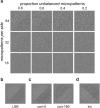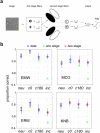Segmenting surface boundaries using luminance cues
- PMID: 33980899
- PMCID: PMC8115076
- DOI: 10.1038/s41598-021-89277-2
Segmenting surface boundaries using luminance cues
Abstract
Segmenting scenes into distinct surfaces is a basic visual perception task, and luminance differences between adjacent surfaces often provide an important segmentation cue. However, mean luminance differences between two surfaces may exist without any sharp change in albedo at their boundary, but rather from differences in the proportion of small light and dark areas within each surface, e.g. texture elements, which we refer to as a luminance texture boundary. Here we investigate the performance of human observers segmenting luminance texture boundaries. We demonstrate that a simple model involving a single stage of filtering cannot explain observer performance, unless it incorporates contrast normalization. Performing additional experiments in which observers segment luminance texture boundaries while ignoring super-imposed luminance step boundaries, we demonstrate that the one-stage model, even with contrast normalization, cannot explain performance. We then present a Filter-Rectify-Filter model positing two cascaded stages of filtering, which fits our data well, and explains observers' ability to segment luminance texture boundary stimuli in the presence of interfering luminance step boundaries. We propose that such computations may be useful for boundary segmentation in natural scenes, where shadows often give rise to luminance step edges which do not correspond to surface boundaries.
Conflict of interest statement
The authors declare no competing interests.
Figures








References
-
- Marr D. Vision: A Computational Investigation into the Human Representation and Processing of Visual Information. Henry Holt and Co., Inc.; 1982.
Publication types
LinkOut - more resources
Full Text Sources
Other Literature Sources

